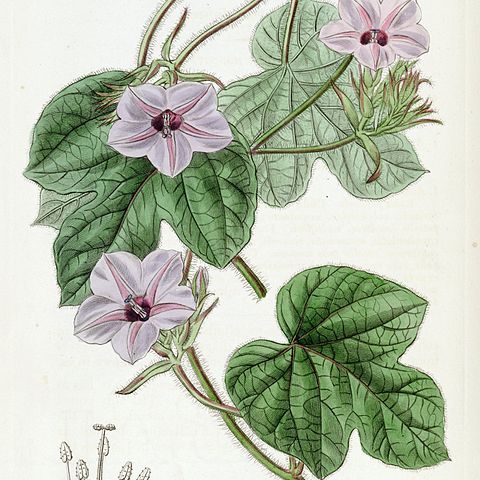Twining or prostrate annual herb. Leaves broadly cordate-ovate in outline, deeply 3-lobed, rarely entire, covered with dense white cottony tomentum beneath. Sepals lanceolate, long acuminate oraristate; bristly or setose and glandular. Corolla 14-20 mm long. Flowers pink or mauve with darker mauve centre.
Leaf lamina broadly cordate-ovate in outline, up to 18·5–17·5 cm., deeply 3–lobed, rarely entire, acute or acuminate at the apex, thin, green, bristly-pubescent above, covered with dense white-cottony tomentum beneath; petiole 4–10 cm. long.
Flowers several in lax cymes; peduncle 1·5–7 cm. long; secondary and tertiary branches 1·5–3 cm. long; bracts ovate-lanceolate with a broad base, long-acuminate to aristate, up to 11 mm. long; pedicels, somewhat flattened, up to 1 cm. long.
A herb that lies along the ground. It can be twining. It can grow 2.5 m long. The leaves are oval to heart shaped and have 3 lobes. They are 18 cm long by 17 cm wide.
Stems several from the base, twining or occasionally prostrate, up to 2·5 m. long, densely covered with white or yellow bulbous-based patent bristly hairs.
Corolla funnel-shaped, pink or mauve with darker mauve centre, 1·4–2·0 cm. long, pubescent on midpetaline areas near the tips of the corolla lobes.
Sepals subequal, lanceolate, long acuminate or aristate, 1·2–2·5 cm. long, bristly or setose and glandular, accrescent in fruit.
Annual resembling Ipomoea ficifolia Lindl. but with smaller flowers.
Seeds ovoid, black, velvety-white-pubescent.
Capsule ovoid, pubescent above.

